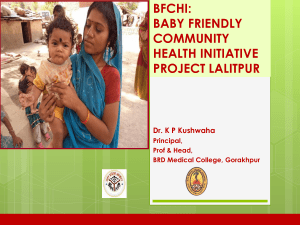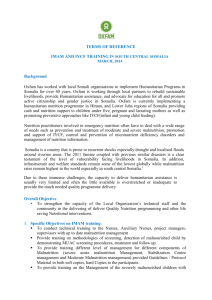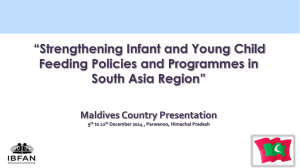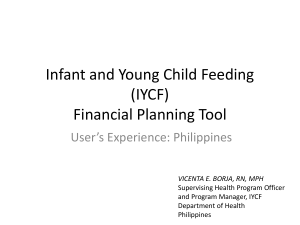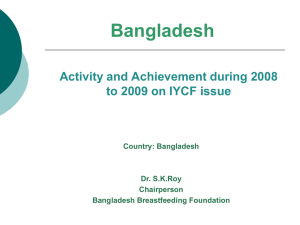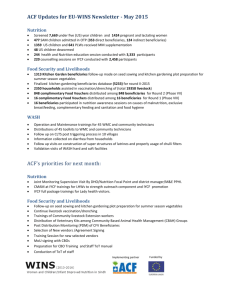Click here to the
advertisement
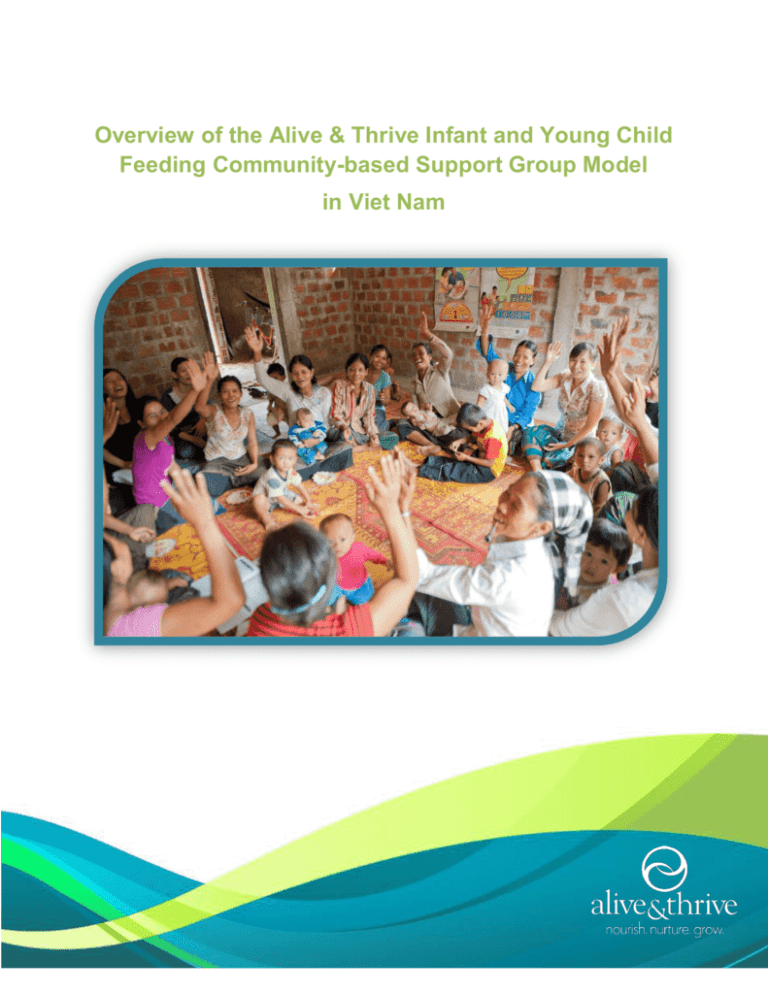
Overview of the Alive & Thrive Infant and Young Child Feeding Community-based Support Group Model in Viet Nam Alive & Thrive is an initiative to improve infant and young child feeding by increasing rates of exclusive breastfeeding and improving complementary feeding practices. The first two years provide a window of opportunity to prevent child deaths and ensure healthy growth and brain development. Alive & Thrive aims to reach more than 16 million children under 2 years old in Bangladesh, Ethiopia, and Viet Nam through various delivery models. Learnings are shared widely to inform policies and programs throughout the world. Alive & Thrive is funded by the Bill & Melinda Gates Foundation and managed by FHI 360. Other members of the A&T consortium include BRAC, GMMB, the International Food Policy Research Institute (IFPRI), Save the Children, the University of California Davis, and World Vision. Suggested citation: Alive & Thrive. Overview of the Alive & Thrive Infant and Young Child Feeding Community-based Support Group Model in Viet Nam. Washington, DC: Alive & Thrive, October 2013. Alive & Thrive Viet Nam Room 203-204, Building E4B, Trung Tu Diplomatic Compound 6, Dang Van Ngu Street, Hanoi, Viet Nam Mobile: +84 (0) 988013503 | Office: +84-4-3573 9066 ext 103 Fax: +84-4-35739063 aliveandthrive@fhi360.org www.aliveandthrive.org www.mattroibetho.vn i Table of Contents Acronyms................................................................................................................................................ iii Introduction............................................................................................................................................. 1 Background.............................................................................................................................................. 2 Rationale for the IYCF support group model ........................................................................................3 Design and process of establishing IYCF support groups .......................................................................... 3 Establish linkages with health services, NGOs, and other community groups ....................................4 Identify topics for IYCF support groups ................................................................................................6 Define criteria for selecting villages for IYCF support groups and identifying IYCF support group facilitators ...........................................................................................7 Clarify the role of the IYCF support group facilitators and enable them to perform ...........................7 Incorporate supportive supervision and monitoring and use the information and data gathered to adapt to the needs of the support groups .............................................................10 Sustaining IYCF support groups .............................................................................................................. 13 Lessons learned ..................................................................................................................................... 14 Figures Figure 1: Alive & Thrive Viet Nam program areas ................................................................................1 Figure 2: A&T support group model within the health support system ...............................................5 Figure 3 Supervision and reporting structure for IYCF support groups .............................................10 Figure 4: Infant and Young Child Feeding Support Group Model: monitoring system .......................13 Tables Table 1: IYCF topics in Support Groups .................................................................................................6 Table 2: Support group and facilitator selection criteria ......................................................................7 Table 3: Training of support group facilitators (CBWs).........................................................................9 Annexes Annex 1: Resource documents .......................................................................................................... 16 Annex 2: Supportive supervision checklist......................................................................................... 17 Annex 3: Monitoring forms and instruction of the IYCF support group model ................................ 18 ii ACRONYMS A&T Alive & Thrive BCC Behavior change communication CHC Commune health center CBW Community-based worker IYCF Infant and young child feeding IYCF SG Infant and young child feeding support group MOH Ministry of Health [Viet Nam] MTBT Mặt Trời Bé Thơ NIN National Institute of Nutrition [Viet Nam] NNP National Nutrition Program POA Plan of Action PMB Provincial management board TOT Training of trainers WHO World Health Organization iii Introduction Alive & Thrive (A&T) is an initiative funded in 2008 by the Bill and Melinda Gates Foundation to reduce morbidity and mortality among children under two by reducing stunting and improving sub-optimal infant and young child feeding (IYCF) practices in Bangladesh, Ethiopia, and Viet Nam. Driven by the desire to prove that IYCF intervention models could be applied at scale in three different contexts, A&T developed a program model that centered on social and behavior change communication delivered through interpersonal communication and mass media, in addition to policy advocacy, community mobilization, and an emphasis on monitoring and evaluation and the strategic use of data. Although child undernutrition (underweight and wasting) has declined considerably in Viet Nam over the last decade, the stunting rate remains high. Nationwide surveillance data from the National Institute of Nutrition (NIN) show that as of 2011, the rates of stunting and underweight children in Viet Nam are 27.5%, and 16.8%, 1 respectively. This high rate of stunting can be attributed, in part, to sub-optimal feeding practices in early life. The ‘window of opportunity’ for reducing stunting and promoting healthy growth and brain development in young 2 children is in the first 1,000 days, or the period that includes gestation and the first two years of life. In addition to stunting reduction, improved feeding practices during this period Figure 1 Alive & Thrive Vie Nam Program Areas 3 can reduce infections and the risk of mortality. Beyond this “window of opportunity,” stunting is largely irreversible with long-term effects. Higher performance in school, lower risk of chronic diseases, and higher future incomes are all associated 4 with higher stature. With the objective of improving IYCF practices in Viet Nam, Alive & Thrive introduced two models to deliver interpersonal 5 communication: the Mat Troi Be Tho (MTBT) franchise model in health facilities across 15 of Viet Nam’s 63 provinces and IYCF support groups in 8 provinces to reach ethnic minority mothers who live in more remote areas and who are less likely to access health facilities. The focus of both models is on the last trimester of pregnancy through the child’s first two years of life. Figure 1 shows the 15 provinces where Alive & Thrive Viet Nam operates (in green). Of those, several in the Central and Southern region of Viet Nam have established IYCF support groups. These provinces include Quang Binh, Quang Tri, Quang Nam, Quang Ngai, Dak Lak, Khanh Hoa, Dak Nong, and Ca Mau. 1 National Institute of Nutrition. NIN surveillance report on feeding practices in 63 provinces. Ha Noi, Viet Nam: NIN, 2011. Maternal and child undernutrition: effective action at national level. The Lancet. Bryce. 2008. 3 What works? Interventions for maternal and child undernutrition and survival. The Lancet. Bhutta. 2008. 4 Maternal and child undernutrition: consequences for adult health and human capital. The Lancet. Victora. (2008). 5 Alive & Thrive. Franchisee Manual: Standards and Procedures for Managing Franchisee Operations to Improve Infant and Young Child Feeding. Hanoi, Viet Nam: Alive & Thrive, October 2013. 2 1 Between November 2011 and March 2013, a total of 675 IYCF support groups were established in 225 villages in 76 communes in these eight provinces of Viet Nam. On average, the IYCF support groups reach 68 percent of pregnant women, 74 percent of mothers with children less than 6 months, and 59 percent of mothers with children 6-23 months. The total number of contacts through IYCF support groups during this period was approximately 59,000. PURPOSE OF THIS OVERVIEW DOCUMENT The purpose of this overview document is to describe the IYCF support group model, how it was established, and the tools used in its implementation. The paper focuses on the IYCF support groups which have been established for pregnant women and mothers of children 0-5 months; mothers of children 6-23 months; and fathers, grandmothers, and other community members in remote areas where ethnic minorities reside. IYCF support groups promote optimal breastfeeding and complementary feeding practices by providing a space where participants can share knowledge, information, and their own IYCF experiences as well as provide mutual support to one another. IYCF support groups are facilitated by trained community-based workers (CBWs) who have IYCF knowledge and have mastered some group dynamic facilitation skills. Background Viet Nam has undergone dramatic economic growth and social development over the past decades. Much effort has been invested in improving children’s health and nutrition. Significant progress has been made in reducing malnutrition among under-five children; however, challenges remain. Stunting still affects one-third of Viet Nam’s children. Viet Nam’s National Nutrition Strategy for 2011-2020 aims to reduce these rates by 2020 to 23% for 6 stunting and 12.5% for wasting. Malnutrition rates among ethnic minority are much higher than rates among their 7 Kinh counterparts. Reducing the inequities that exist between urban and rural or mountainous areas and between the Kinh majority group and ethnic minority groups will go a long way toward achieving the national targets for 2020. Barriers to good practices. Improving breastfeeding and complementary feeding practices requires addressing sizable challenges for these groups. 6 7 Prevailing customs prevent optimal IYCF practices, causing high malnutrition rates. For example, almost onefifth of mothers interviewed during the formative research phase believed that colostrum was poisonous and National Nutrition Strategy for 2011-2020, with a Vision toward 2030. Medical Publishing House. Hanoi. 2012 National Institute of Nutrition. NIN surveillance report on feeding practices in 63 provinces. Ha Noi, Viet Nam: NIN, 2011. 2 should be discarded. Most grandmothers reported that they had fed newborns honey, licorice, or lemon to 8 cleanse the tongue or keep babies cool. Poor economic conditions force rural and ethnic mothers to return to work early without any maternity entitlements, resulting in the use of infant formula or early introduction of complementary foods. Difficulties in accessing healthcare facilities prevent mothers and other caregivers in remote areas from accessing information and support about nutrition and recommended child feeding practices. RATIONALE FOR THE IYCF SUPPORT GROUP MODEL The formative research conducted by A&T identified barriers to optimal IYCF practices that were unique among Viet Nam’s ethnic minorities. The formative research also suggested that reaching minority groups through the MTBT franchises established within the public health system would not be effective given the low rates of utilization of health services among non-Kinh women. To provide access to knowledge, sharing, and support of recommended IYCF practices to those living in relatively remote areas with poor access to health facilities, Alive & Thrive launched the IYCF support groups. Box 1: Support group characteristics Informal Peer-led Culturally sensitive Supportive Grassroots How can an IYCF Support Group address barriers to good feeding practices? Through the IYCF Support Group Model, A&T aims to reduce the barriers to optimal IYCF practices faced by this particular group of mothers by: Providing mothers of children under two in remote areas the opportunity to access IYCF information and support during support group meetings in their own village instead of traveling long distances to health facilities; Creating an informal forum for mothers and caregivers to learn and share knowledge and their own experiences on IYCF practices with each other; Customizing and adapting interventions to address prevailing customs in a culturally sensitive manner that enhances people’s knowledge, attitudes, and IYCF practices; Enabling decision-makers in the family to improve their awareness and support mothers to apply good IYCF practices; and Creating an environment at the grassroots level that enables mothers to optimally feed their infants and young children. Design and process of establishing IYCF Support Groups Building on previous experience with the positive deviance approach, Save the Children spearheaded the A&T IYCF support groups established for pregnant women; mothers of children under two; and fathers, caregivers, and community members. In the IYCF support group model, three kinds of support groups were organized at the village level: 8 A&T unpublished data. 3 1. Group 1: a group of pregnant women in the last trimester and lactating mothers with children under 6 months old (meets once a month) 2. Group 2: a group of lactating mothers and caregivers with children from 6 up to 23 months old (meets once a month) 3. Group 3: a group of family members who influence feeding decisions in households with children under two (meets every 2 months) The design and steps in establishing IYCF support groups are described below. ESTABLISH LINKAGES WITH HEALTH SERVICES, NGOS, AND OTHER COMMUNITY GROUPS Systems and policies need to be in place to support implementation of a range of community IYCF activities including community-based support groups. These should be linked to and integrated with existing health and nutrition services. The National Plan of Action on IYCF 9 for 2012-2015 (POA), the National Nutrition Box 2: The National Plan of Action on IYCF lists (and 10 describes) the following main solutions including the Strategy for 2011-2020 (NNS), and the 11 promotion of community-based support groups: National Nutrition Program (NNP) of Viet Nam provide evidence that the required systems and policies are in place. The objective of the National Plan of Action on Infant and Young Child Feeding for 2012-2015 is to improve knowledge and practice on IYCF and maternal nutrition to contribute to stunting reduction and to improve the development of children aged 0 to 2 years. The focus of the National Nutrition Strategy for 2011-2020 is on education, training, capacity building, and strengthening of policies that support nutrition initiatives, institutionalization of state direction for nutrition activities, and 12 continuation of national target programs.” The National Nutrition Strategy (NNS) also promotes “nutrition groups for pregnant women to share experiences on nutrition care in order to provide support for women and help to increase nutrition knowledge and practices, encouraging healthy fetal growth.” 1) Build capacity of management, coordination, and development of IYCF and maternal health-related policies. 2) Develop prioritized IYCF intervention packages for each province, district, and vulnerable group to centralize resources and strengthen the effectiveness of interventions. 3) Enhance advocacy efforts and behavior change communication on infant and young child feeding and maternal health. Strengthen the roles of community-based support groups in IYCF counseling. 4) Build capacity of health workers at all levels on IYCF and maternal health. 5) Accelerate coordination, planning, monitoring, and supervision activities among government agencies, mass media, and international organizations. 6) Strengthen the supervision system to monitor the progress, quality, and impacts. 7) Mobilize different funding sources to implement the Plan of Action. 9 Approval 2013-01-31 IYCF Action Plan VN Decision 304 National Nutrition Strategy for 2011-2020, with a Vision toward 2030. Medical Publishing House. Hanoi. 2012 11 Personal correspondence 12 National Nutrition Strategy for 2011-2020, with a Vision toward 2030. Medical Publishing House. Hanoi. 2012 10 4 The IYCF support group model contributes to creating complementary messages to reinforce objectives throughout the health system. By concentrating on remote ethnic minority areas, the IYCF support group model is a vehicle to expand coverage to pregnant and lactating women, mothers of children up to 24 months, other caregivers, and families. This support group model is supported by existing structures at all levels: village head, Women’s Union, People’s Committee, Commune Health Center (CHC), and District and Provincial Management Board (PMB). See Figure 2 below. Figure 2: A&T Support Group Model within the Health Support System13 13 ‘Nutrition Collaborator’ is a term used by Protein Energy Malnutrition Control (PEMC). Nutrition collaborators make household visits once a month and at 42 days postpartum. ‘Women’s Union’ (WU) operates throughout Viet Nam at four administrative levels (central, provincial, district, and commune) with a total membership of more than 13 million women. WU is mandated to protect women’s legitimate rights and strive for gender equality. 5 IDENTIFY TOPICS FOR IYCF SUPPORT GROUPS A&T focused on IYCF practices recommended by WHO and endorsed by NIN. The formative research helped prioritize the following messages: Give no water to babies even in hot weather; breastmilk contains enough water Begin breastfeeding immediately after delivery (within the first hour) Exclusively breastfeed for 6 months - no water, formula milk, or any other foods At 6 months begin to give a variety/diversity of foods (give foods from the 4 groups) Give iron-rich foods (animal and organ meats and eggs) For support group 1, which is for pregnant women and mothers of infants younger than 6 months old, the topics focus on the nutritional needs of pregnant women and promotion of early and exclusive breastfeeding. Group 2, for mothers of children 6-23 months, priority is given to discussing age-appropriate complementary feeding and continued breastfeeding through 24 months. Group 3, for key family members who have children under 2 in the family, discussions center around causes and consequences of child malnutrition and how to provide family/community support of recommended IYCF practices. Fifteen topics are divided among the three types of support groups as outlined in Table 1 below. Table 1: Topics of IYCF in Support Groups Exclusive Breastfeeding (EBF) Support Group Complementary Feeding (CF) Support Group Community Support Group Pregnant women in the last trimester and lactating mothers with infants under 6 months old Lactating mothers and caregivers with children from 6 up to 24 months old Key family members who have children under 2 in the family 1) Nutrition during pregnancy and breastfeeding 6) Feeding children, according to age, with a sufficient frequency of meals and sufficient amount and thickness of food each day 7) Feeding children diverse foods at each meal (4 food groups) 13) Causes and consequences of child malnutrition 2) Initiation of breastfeeding within one hour of birth 3) Exclusive breastfeeding in the first 6 months 4) Positioning and attachment of baby at breast 5) Preparation for complementary feeding. 8) How to prepare a hygienic meal 14) Support from family and the community in breastfeeding 15) Support from family and the community in complementary feeding 9) Nutrition care for child during sickness (illness) and recovery 10) Nutrition care for child with diarrhea and acute respiratory infections 11) Responsive feeding – helping a child to eat well 12) Cooking demonstration 6 DEFINE CRITERIA FOR SELECTING VILLAGES FOR IYCF SUPPORT GROUPS AND IDENTIFYING IYCF SUPPORT GROUP FACILITATORS The following set of criteria was applied (Table 2) to decide in which villages IYCF support groups would be established. Village selection was based on the need in a community as well as interest among local authorities, health staff, and community members. Once villages were selected, support group facilitators were chosen by the commune health center (CHC) staff designated as the responsible party for implementation of the IYCF support group model in the village. Facilitators were chosen from existing cadres of community-based workers (CBWs), 14 which included village health workers (VHWs) , Women’s Union members, and Nutrition Collaborators. Because they had been working closely with the CBWs in their area, CHC staff knew the strengths and limitations of the community-based workers. In most IYCF support group villages, two CBWs were selected to be trained as support group facilitators along with the Village Head. Village Heads are important because they mobilize the community and promote attendance at the support groups. Table 2: Support Group and Facilitator Selection Criteria Support group selection criteria Support group facilitator criteria Local authorities are enthusiastic and committed to supporting IYCF practices. Commune health staff, community-based workers, and women are active and enthusiastic about being involved in the project. Health facilities are more than 5 kilometers away from the village. Local households are living within the radius of 2 kilometers of the village hall/central place in the village where meetings can be held. At least 10 pregnant women and mothers with children under two live in the village. The stunting rate in the village is equal to or higher than national average (27%). Poor IYCF practices are prevalent. Local person living in the village, familiar with the culture and participating mothers Speaks local dialect Lives in the village and is accepted by her/his community and health personnel Desires to learn and share experiences and knowledge with other members of the community Caring, considerate, and respectful Has time, energy, and support from family Open to learn good listening and communication skills, and effective question-posing skills (successfully demonstrated during training) CLARIFY THE ROLE OF THE IYCF SUPPORT GROUP FACILITATORS AND ENABLE THEM TO PERFORM A&T focused on enabling those chosen as group facilitators to assume their roles. A&T, working with provincial, district, and commune authorities, provided training, developed job aids, and offered supportive supervision and 14 Administratively, VHWs work at the village level as a part of the primary health care network. VHWs are contracted and financed by the local authorities - Commune People’s Committees. Technically, performance of VHWs is directly supervised and monitored by Commune Health Centers (CHCs) and District Health Offices. Tasks and functions of the VHWs have been identified by the MOH. VHWs have five major responsibilities: 1) health education and communication, 2) community hygiene and health prevention, 3) maternal and child health care, 4) first aid and basic curative care, and 5) public health programs. 7 incentives. The IYCF support group facilitators were selected from cadres of existing CBWs. Facilitating IYCF support groups increases their work load, for which they receive a small monthly stipend. It was important to clearly define what was expected of IYCF support group facilitators and how they would interact with the CHC staff. The IYCF support group facilitators were then trained and provided with job aids to help them conduct support group meetings. The training focused on increasing facilitators’ knowledge of the recommended IYCF practices and developing their skills to lead and facilitate group discussions. The role of the IYCF support group facilitator is described below, followed by a description of the training they received and information about the counselling cards they use. Issues invitations to support group meetings. As part of their original duties, CBWs were already expected to conduct monthly household visits. Facilitators use these visits as an opportunity to invite pregnant women, lactating mothers, and community members to attend an IYCF support group. They often give a written invitation, which includes information about the type of support group, place, date, and topic. Plans, prepares, and facilitates support group meetings (Groups 1 and 2 every month, and Group 3 every 2 – 3 months) Motivates the participation of as many members of the community as possible Prepares refreshments for meeting Collects information that has been agreed upon Reports monthly the results of group activities to the commune project management board so that the board in turn can report to the district level Attends monthly meetings at commune health center. CBWs (VHWs, Nutrition Collaborators, and Women’s Union members) and Village Heads attend monthly meeting at the CHC, submit support group reports, and plan the following month’s meetings Training. In 2011, an A&T training specialist and regional managers designed and developed two documents: the Support Group Trainer Manual 4: Behavior Change Communication on Infant and Young Child Feeding in Remote Areas and the Support Group Trainee Handbook 4: Behavior Change Communication on Infant and Young Child Feeding in Remote Areas. The manual was designed for use by provincial/district trainers to train CBWs. In May 2012, A&T trained trainers, who then cascaded the instruction to CBWs. For each support group village, three people were trained as support group facilitators (2 CBWs and the Village Head). Table 3 shows the types of training and numbers trained. 8 Table 3: Training of Support Group Facilitators (CBWs) Training Manuals Training period Target group Number trained by cadre Doctor Nurse/ Completed by CBWs Total Midwife Support Group Trainer Manual 4 7 days District trainers 70 30 - 100 May-12 Roll out Manual 4 5 days CBWs - 132 776 908 Nov-12 TOT IYCF Support Group Protocol 2 days Trainers 98 42 0 140 Jan-13 Roll out: IYCF SG protocol 2 days CBWs 0 373 737 1,110 May-13 The training manual for the IYCF Support Group model includes four chapters: Chapter 1. Introduction to the A&T project Chapter 2. Messages for improving IYCF practices Chapter 3. Organizing IYCF support groups in villages Chapter 4. Monitoring books, recording forms, and reports Each session consists of five parts: Learning objectives: The knowledge and practice that trainees gain from each session Teaching methods: Method of teaching used for each part of the session Activities and time: Which activities and how much time is allocated for each activity in the session Facilities and materials: Facilities and materials to be prepared Facilitation instruction: Detailed steps for each activity in the session, including both theory and practice This trainer’s manual is complemented with Support Group Trainee Handbook Four, which contains handouts and reference materials for trainees at the commune and village levels to be used during training and also as a guide for planning and conducting IYCF Support Groups. The quality of the training is ensured through pre/post assessments, training support provided to district facilitators/trainers from A&T provincial managers, and local support to CBWs from CHC staff and district facilitators/trainers while CBWs facilitate their first support groups. 9 Counseling Cards. In addition to the instruction on how to facilitate IYCF Box 3: Counseling Cards support group meetings for each topic, A&T provided CBWs with a set of 21 Counseling Cards (box 4) that are attractive and easy to understand. Developed for use at the MTBT franchises, these Counseling Cards are job aids for the facilitator to guide the discussions. They were designed as pictorials to help target audiences remember the messages without having to read. The front side of the counseling card is a visual to reflect the communication messages, while the back contains main contents of the messages. Some general guidelines are provided at the beginning of the counseling cards on “how to use counseling cards.” The use of the individual counseling card depends on the kind of support group and the topic of the day. INCORPORATE SUPPORTIVE SUPERVISION AND MONITORING AND USE THE INFORMATION AND DATA GATHERED TO ADAPT TO THE NEEDS OF THE SUPPORT GROUPS Supportive Supervision. The supervision system for the IYCF support group model was integrated into the existing supervision structure of the MOH. Provincial and district supervisors received a 2-day training focused on how to provide supportive supervision. One or two CHC staff members were assigned to supervise the support group facilitators. The supervisor attends all the support groups and supervises the facilitators every month. The Box 4: The following topics are covered in each of the District Secretary supervises the support group Counseling Cards: facilitators every 2 months, though very remote villages 1. Nutrition for pregnant women, might be supervised less frequently. When members of 2. Nutrition for lactating women, the Women’s Union belong to the District Project 3. Timing of breastfeeding initiation, Management Board (PMB), they also supervise support 4. Composition of first milk – colostrum, group facilitators. The supervisors at all levels (commune, district, and A&T staff) use the Supportive Supervision Checklist (Annex 2) every time they supervise an IYCF support group facilitator. After the support group meeting, the supervisor sits with the facilitator(s), gives feedback on the meeting topic and skills, and together plans for the next month. To resolve urgent matters, the Project Secretaries at the commune and district levels can call A&T managers at the provincial level to discuss possible solutions. During quarterly meetings of the Provincial Management Boards, relevant issues are brought up for discussion and decisions are made about which support groups will receive supervision visits in the next quarter. Decisions are made based on monitoring data. Figure 3 depicts the supervision and reporting structure for the IYCF support groups. 5. Feeding the newborn, 6. Breastmilk production and quantity, 7. Positioning and attachment, 8. Breastmilk composition, 9. Exclusive breastfeeding in the first six months, 10. Breastmilk and formula milk, 11. Expressing and storing breastmilk, 12. Breastfeeding during illness, 13. Breastfeeding duration, 14. Introduction of complementary foods and feeding a child 6 to 8 months old, 15. Complementary feeding a child 9 to 11 months old, 16. Complementary feeding a child 12 to 23 months old, 17. Process of preparing complementary food, 18. Iron rich food, deworming, and vitamin A supplementation, 19. Good hygiene practices, 20. Responsive feeding, and 21. Feeding a sick child. 10 Figure 3 Supervision and reporting structure for IYCF support groups Following the initial trainings, supportive supervision of support group facilitators revealed that they needed more practice in group facilitation skills. The Guidelines for facilitating a community-based support group meeting on IYCF (Annex 3) were developed to bolster the facilitation skills of CBWs. The guideline focuses on the practice of five steps to facilitate a support group: Step 1: Review the topic of the previous meeting Step 2: Learn about the mothers’ experiences on the new topic Step 3: Share information and optimal practices on the new topic Step 4: Agree on which practices are to be implemented at home Step 5: Evaluate the meeting and plan for the next meeting 11 Based on the guidelines, a 3-day refresher training was planned for the first quarter of 2013. Again, a training of trainers was conducted for provincial and district level trainers who cascaded the training to CBWs. Monitoring. One important component of the IYCF support group model is the introduction of routine monitoring which takes advantage of village level data already available and links with the commune health center. Before IYCF support groups were introduced, each village had a population collaborator who was responsible for keeping updated records for the MOH on pregnant women and mothers with children under 2 years. These form the base of the monitoring system for the IYCF support groups, allowing A&T to estimate the size of the target groups in each village. A&T introduced three additional forms to be used by the support group facilitators (Annex 3). 1) Form CD1, List of pregnant women 7 – 9 months and mothers who have children under 2 years Each month, during the support group meetings, the facilitators ask participants whether they continue to exclusively breastfeed and record their responses. In this way, they track the number of months that each mother in their group exclusively breastfeeds. 2) Form CD2, the IYCF Support Group Record Facilitators use this form to report the type of support group, the topic of the meeting, the date, and the number of participants. 3) Form CD3, the Household Visit Record This form allows facilitators to track household visits, recording the date, the name of the pregnant woman or mother, the type of support group that she attends, any problems detected, counseling content, and change in practice after 1-3 months of counseling. Each month the support group facilitators and the village head meet with the CHC staff responsible for the support group implementation and bring forms CD1 – CD3. The meeting provides an opportunity to give and receive feedback, discuss difficulties, answer questions, and plan for the next month. These data are synthesized at the commune level using a monthly report for IYCF support groups (form CDB, the commune level report). CHC staff submit the commune level report to the district level by the 5th of the month. The district aggregates the data from communes using the monthly report for IYCF support group at district (form CDBH, the district level report), which the district supervisor sends to the province by the 10th of the month. By the 15th of the month, the province secretary sends the information to A&T regional offices, which compile data for various provinces and submit to the A&T office in Hanoi and to NIN. See Annex 3 for Monitoring Tools. 12 Figure 4: Infant and Young Child Feeding Support Group Model: Monitoring System Sustaining IYCF support groups Support groups are labor and time intensive. For continued operation of an IYCF support group program, consideration needs to be made from the outset on how to cover support group expenses such as transportation expenses incurred by support group facilitators and their supervisors, the refreshments served at support group meetings, and incentives provided to facilitators. It is important to decide not only what expenses will be covered, but also what are the expectations of the local authorities to cover the costs that need to be maintained and/or phased out in the implementation and scale-up of the IYCF support group program. Involving local stakeholders in 13 the planning of the IYCF support group model lays the ground work for commitment to sustaining the model. This requires a great deal of advocacy at various levels. Aside from financial sustainability, another critical factor necessary to sustain the support group model is the perception of social support among participants. The listening-dialogue-action approach of the support group model is intended to enhance a pregnant woman/mother/caregiver’s perception of control and empowerment. In some settings the type of personal sharing that is encouraged at support group meetings may be culturally and socially difficult, which may result in declining participation. Participants and local stakeholders must also perceive that these support groups create a sense of community and result in positive behavior change for these groups to be sustained. Thus far, facilitators and support group participants express interest in maintaining and sustaining the support group model. As one participant stated during interviews with provincial level staff, “Support groups are a grassroots activity - make it all about the demands of the mother.” Lessons Learned After several years of implementing the support group model in Viet Nam, several lessons learned have been identified. Though these might be specific to the Viet Nam context, they are included below for the benefit of others who might be considering replicating this approach. The IYCF support group model requires leadership and ownership at all levels. The model is very much dependent on the actions of existing cadres of government employees. They must be driven to address child undernutrition and have the ability to motivate other people. Identifying these champions for IYCF at all levels can make the support group model function optimally. Improving the facilitation skills of community-based workers is as important as increasing their IYCF knowledge. Because this model is aimed at addressing IYCF in remote areas with limited access to health services, prevalent beliefs and practices can vary substantially from one village to another. Facilitators not only need to have correct knowledge about the ideal IYCF practices, but also to be able to get mothers in their community to assess their current practices, decide for themselves whether they want to adopt new behaviors, and motivate and support them to take action. The protocol for support group meetings emphasizes the facilitation process in addition to promotion of optimal behaviors. Supportive supervision visits also offer the opportunity to model facilitation skills. Planning for sustainability is challenging and requires long-term, persistent advocacy. This model was supported by intense advocacy efforts targeting provincial and district authorities to raise awareness of the importance of IYCF, the detrimental effects of stunting, and how proven interventions can improve both. Advocacy efforts have also promoted increased funding for IYCF services in the annual provincial plans for nutrition. Since the support group model is aligned with national policy, funds from the National Nutrition Program funds can potentially be used to continue funding the IYCF support groups. However, national and local authorities must perceive them to be effective. 14 Annexes Annex 1: Resource documents Annex 2: Supportive Supervision Checklist Annex 3: Guidelines for facilitating a community-based support group meeting on IYCF Form CD1, List of pregnant women 7 – 9 months and mothers who have children under 2 years Form CD2, the IYCF Support Group Record. Facilitators use this form to report the type of support group, the topic of the meeting, the date, and the number of participants. Form CD3, the Household Visit Record 15 ANNEX 1: RESOURCE DOCUMENTS Document Type Manual Reference Alive & Thrive. Support Group Trainer Manual 4: Behavior Change Communication on Infant and Young Child Feeding in Remote Areas. Hanoi, Viet Nam: Alive & Thrive. 2011. Summary This manual was developed as a resource for trainers to use for training IYCF Support Group Facilitators. Materials include plans for each session of the training including objectives for each session, a description of how to allot time during the session, a description of methods to be used, including dynamic exercises and a list of materials needed and instructions for how trainers should prepare for the session. The training is divided into four parts as follows: Part I includes 3 sessions which provide an overview of IYCF in Viet Nam and the Alive & Thrive Support Group model; Part II describes key IYCF messages in 11 sessions; Part III is comprised of 8 sessions focusing on how to organize and facilitate support groups; and Par IV reviews monitoring and reporting. Document Type Handbook Reference Alive & Thrive. Support Group Trainee Handbook 4: Behavior Change Communication on Infant and Young Child Feeding in Remote Areas. Hanoi, Viet Nam: Alive & Thrive. 2011. Summary The handbook serves as a reference for trainees on the topics covered during the training. Document Type Gudielines Reference Guidelines for facilitating a community-based support group meeting on infant and young child feeding Summary The guidelines aim to support community-based workers in organizing and facilitating infant and young child feeding support group meetings in the community in an efficient, effective manner. The guidelines provide specific steps – what to do, how to do it, and which tools to use. Document Type Counseling Cards Reference Infant and Young Child Feeding Counseling Cards Summary This set of 21 counseling cards, covering all 15 support group topics, serves as a job aid for IYCF support group facilitators to use during meetings. The set includes a generic set of instructions about support group facilitation for the IYCF Support Group leader. The cards include a pictorial depiction of the information to be conveyed, intended to be to be appropriate for participants, regardless of their literacy level. Written instructions for the facilitator regarding the key messages to be conveyed when showing each card accompany the pictorials. 16 ANNEX 2: SUPPORTIVE SUPERVISION CHECKLIST Province: .............................. District: ................................ Visit date: ____/_____/201__ Commune: ........................... Village/Hamlet ................................ SUPPORTIVE SUPERVISION CHECKLIST - for each group meeting IYCF SG facilitator(s): .............................................. Group: 1. Breastfeeding Supervisor's name:……………………………………… from 1. Province / A&T; No. I 2. District; 2. Complementary feeding 3. Commune Contents 3. Community Rank Good Not good Notes Organization and staff: 1 Place is clean with adequate light 2 Not overcrowded (<20 participants) 3 Participants were arranged in circle 4 Follow timeline 5 Trained facilitator(s) 2 Process of the group counseling: 6 Introducing & greating Step 1 : Reviewing previous meeting topic: 7 * Reviewing information 8 * Assessing the adoption of agreed behaviors 9 * Discussing/sharing experience Step 2 : Assessing experience about the topic 10 * Introducing the new topic 11 * Exploring current practice 12 * Identifying participants with good practice Step 3: Sharing information about new topics: 13 * Using counseling card/ material 14 * Giving relevant, adequate, accurate information 15 * Summarizing key message Step 4: Planning for new behaviors 16 * Agree on what to do at home 17 * Discussing on how to adopt new behaviors 18 * Exchanging experience of participants 19 Step 5: Summarizing & planning for next meeting 3 Counselor skills: 20 Using open-ended questions 21 Listening, praising 22 Presenting clearly, confidently, and persuatively 4 5 Recording and Reporting: 23 Have record 24 Information accurate, clear, and up to date The mother's behavior The rate of mother report EBF ( target: 50%) - Recorded in CBW ow n book and reported by CHC staff The rate of mother report giving animal source foods at least 2-3 times a week (Target: 40%) High 6 Quality Assessment Medium Low - High Quality w hen 20/24 items are good and target for mother behaviors are gained (50%&40%) - Medium: 15/24 items are good and the 2 mother's behaviors gained from 30% <15/24 are good. 17 ANNEX 3: MONITORING FORMS AND INSTRUCTION OF THE IYCF SUPPORT GROUP MODEL CD1 ─ List of pregnant women 7 – 9 months and mothers who have children under 2 years CD1. List of women who were at 7-9 months pregnancy or with children under 2 years old No Mother and child's name Child birth date (1) (2) (4) Year 2012 1 2 3 4 5 6 7 (7) 8 Year 2013 9 10 11 12 1 2 3 4 5 6 7 (8) 8 Year 2014 9 10 11 12 1 2 3 4 5 (9) 6 7 Mother: Child: __.__.__ Mother: Child: __.__.__ Mother: Child: __.__.__ Mother: Child: __.__.__ Mother: Child: Mother: Name Child: Symbol Mother: Purpose Child: Level/Location Mother: Implementer DataChild: source Time/frequency Management/ Archives Steps to fill out the form Validation/ supervision, support __.__.__ Instruction for CD1 form List of women __.__.__who were at 7-9 months pregnancy or with children under 2 years old CD1 To keep track of mothers from the 7th month of pregnancy until the child is 24 months __.__.__ Provide information to the YB form Hamlets/villages Demand generators (CBW) __.__.__ List of pregnant women from CHCs or CBWs which they manage themselves Update monthly or whenever a new mother/pregnant woman comes to the center Form CD1 is filled and kept by CBW. Fill all information on the cover page: CBW name, village, commune, district, province Column (4) the child's date of birth or expected date of birth: Columns (7,8 and 9): Each column represents 1 month (e.g. 1 is January). CBWs record the nd child's age by month. For example, if a child’s birth date is February 2 2012, in Column 7, the mother would mark a “1” in March, a “2” in April and so on. Note: - If the child is more than 24 months old then cross out the rest of the calendar - If the mother moves to another region or the child has died then note this and cross out the rest of the calendar. A) Supervisor (frequency) 1. Commune health center staff (quarterly) 2. Supervisors from upper level (randomly) B)Testing method: consistency with CDB form C) Checklist 1. Fill out name of CBW, village, general information; 2. Write down the child's age by month 18 CD2 ─ IYCF support group record. Facilitators use this form to report the type of support group, the topic of the meeting, the date, and the number of participants. IYCF SUPPORT GROUP RECORD 1 Breast feeding group (Pregnant women and Mothers with children < 6 months) 2 Complementary feeding group (Mothers with children 6-23.9 months) 3 Community group (Fathers, and others such as grandparents, other relatives...) Number of participants Group Topics Group 1 Date Group 2 Group 3 Pregnant women Mothers with a < 6 mo olds Mothers with a 6-23.9 mo olds Fathers Others (A2) (A3) (B2) (C2) (C3) Instruction for CD2 form Name IYCF support group record Symbol CD2 Purpose To keep track of service delivery in IYCF support groups in each village Provide information to the CD3 form Level/Location Hamlets/villages Implementer Demand generators (CBW) Data source Based on participants attended the support group meeting Time/frequency After the completion of IYCF support group meeting Management/ Archives Form CD2 is filled and kept by CBW. Fill the number coded for group type in “Group” column; topic of the discussion under “topic”, and date of the group meeting under “Date”. Steps to fill out the form Validation/ supervision, support Fill in the number of participants under column A, B and C, when appropriate. By the end of the month, sum up all number for each column to report to commune health staff. A) Supervisor (frequency) 1. Commune health center staff (quarterly) 2. Supervisors from upper level (randomly) B)Testing method: consistency with CDB form C) Checklist: Completeness of data by months 19 Form CD3 ─ Household visit record This form allows facilitators to track household visits, recording the date, the name of the pregnant woman or mother, the type of support group that she attends, any problems detected, counseling content, and change in practice after 1-3 months of counseling. HOUSEHOLD VISIT RECORD No. Visit date Mother or care giver name Pregnant women Type With children < 6 mo With children 623.9 mo (D2) (D3) (D1) Problems detected Counseling content Practice result after counseling 13 months Instruction for CD3 form Name Household visit record Symbol CD3 Purpose To keep track of household visit done by village health village health workers Provide information to the CD3 form Level/Location Hamlets/villages Implementer Demand generators (CBW) Data source Based on participants visited by CBW Time/frequency After the completion of household visit Management/ Archives Form CD3 is filled and kept by CBW Fill in visit date, mother or caregiver name. Steps to fill out the form Based on the classify participant by ticking on D1 (Pregnant women), D2 (Women with children < 6 months), or D3 (women with children 6-23 months). Indicated problem detected and counseling contents to appropriate column. A) Supervisor (frequency) 1. Commune health center staff (quarterly) Validation/ supervision, support 2. Supervisors from upper level (randomly) B)Testing method: consistency with CDB form C) Checklist: Completeness of data by months 20

